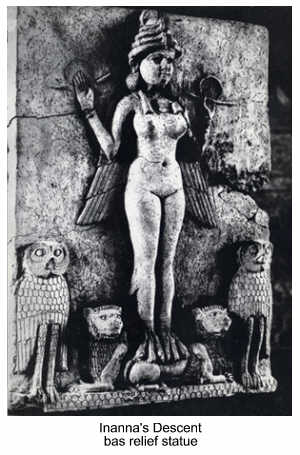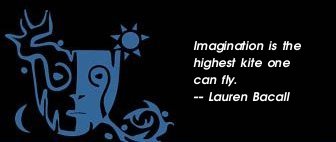
The Masks of Inanna
By Suzanne Prouty
She goes down
As we go down
We follow her underground
Hail to Inanna
Who died
To become born.
— Chant from the writer Starhawk
and the Reclaiming Collective, 1995
 Inanna, as Sumerian myths remind us, descends into her sister Erishkegal's underworld kingdom of the Great Below, dies there, but is reborn. In her descent from the realm of light into the darkness of the netherworld, Inanna passes through seven gates, and at each gate, is forced to leave behind part of her earthly symbols of power - at the first gate, for example, Neti, the chief gatekeeper of the underworld, forces the queen to strip off her shugarra, her crown, and at the last gate, her beautiful robe of sovereignty, the pala, is removed. Thus Inanna enters "naked and bowed low" (Wolkstein & Kramer 60). The Seven Judges of the Great Below, the Anunnaki, then pass sentence on her - "they fastened their eyes on her, the eyes of death" (Kramer141) so that she sickens and dies. Inanna's corpse is hung on a spike, but after three days and three nights Inanna is revived, and rises from the dead to return to the Great Above of the earth and sky. Inanna, as Sumerian myths remind us, descends into her sister Erishkegal's underworld kingdom of the Great Below, dies there, but is reborn. In her descent from the realm of light into the darkness of the netherworld, Inanna passes through seven gates, and at each gate, is forced to leave behind part of her earthly symbols of power - at the first gate, for example, Neti, the chief gatekeeper of the underworld, forces the queen to strip off her shugarra, her crown, and at the last gate, her beautiful robe of sovereignty, the pala, is removed. Thus Inanna enters "naked and bowed low" (Wolkstein & Kramer 60). The Seven Judges of the Great Below, the Anunnaki, then pass sentence on her - "they fastened their eyes on her, the eyes of death" (Kramer141) so that she sickens and dies. Inanna's corpse is hung on a spike, but after three days and three nights Inanna is revived, and rises from the dead to return to the Great Above of the earth and sky.
This descent and rebirth, a common initiatory ritual, is "often characterized by a symbolic descent into and ascent from the labyrinthine Earth Mother…Inanna is Queen of Heaven and Earth, but she does not know the underworld…To enter the spiritual realm of the Great Below, Inanna must give up her earthly powers" (Wolkstein & Kramer 148). Once she has experienced this death, she gains wisdom. She is changed, for "no one ascends from the underworld unmarked" (op. cit. 161). For Jungian analysts Baring and Cashford, this descent reflects that "Inanna as the moon is the life principle that seeks its own sacrifice and is reborn from its own darkness" (193), as the moon spends three days in the dark each month.
Just as this myth is about the power of transformation, it also marks a transformation of Inanna into a goddess remembered. For long before this version of the descent myth was told in Sumeria and later retold by the Semitic invaders who absorbed Sumer into the culture of Babylon, Inanna knew the wisdom of the Underworld as an integral part of her divinity.
Inanna is a primary descendent of the Neolithic Bird and Snake Goddess; with Isis of Egypt and Cybele of Anatolia she represents one of the three Bronze Age great goddesses, or Great Mother goddesses. "These goddesses often take on the [Neolithic]characteristics of bird and snake, perennial images of transcendent heights and underworld depths…(T)he Neolithic, in its artistry, suggests a creative interplay of the immanent and the transcendent" (Keller 25). The trinity of Inanna, Isis, and Cybele embodied feminine attributes of the mystery of life, which includes death as an aspect. "The mystery of the female body is the mystery of birth, which is also the mystery of the unmanifest becoming manifest in the whole of nature" (Baring & Cashford 8).
The Neolithic period is the last phase of the Stone Age. Inanna incorporates Stone Age bird goddess imagery in later Bronze Age renderings, as seen in the Burney Relief, a terracotta plaque of Inanna dated from 2300-2000 B.C.E. She is flanked by two owls. In her bird form, the Sumerians named her "Divine Lady Owl," or Nin-Ninna. A cylinder seal (2334-2154 B.C.E.) shows Inanna with a staff of intertwined serpents and "both the serpents and the wings springing from her shoulders show her descent from the Neolithic Bird and Snake Goddess…" (op. cit. 176). The serpent can shed its skin and be reborn.
Both serpents and dragons (from the Greek drakon, or serpent) share many of the same attributes, notably the archetypal feminine attributes of nourishment, control of water, and rebirth. Cylinder seals showing a goddess believed to be Inanna portray her standing on a dragon, for she is addressed in hymns as the dragon (Baring & Cashford 201). It may be she who is prayed to as "my dragon who walks by side" (Smith ix). Inanna's dragon aspect marks her underworld divinity.
The dragon is a powerful mythic symbol that represents feminine principles. Often associated with mountains (breasts) and caves (vagina or womb), Sumer's dragons are said to dwell in the great abyss of depth and nothingness, the nether world. In that the word for the great dragon of the abyss in Sumerian myths is the same as the word for the underworld itself (kur), some of their attributes may be conflated and thereby become synonymous. "The serpent and the dragon reveal her [Inanna's] connection with the underworld aspect of the Neolithic goddess and with Nammu, the serpent goddess of the abyss" (Baring & Cashford 195).
Mesopotamia, like Egypt, was intimately involved with water. The Nile, the Tigris, and the Euphrates all have similar flood stages that are necessary but destructive. Water was both life giver and enhancer as an irrigator and death dealer when the floods raged, which tie the dragon to the attributes of life giving sustainer, coupled with death. Just as the golden Durga lives inside the death dealing Kali in the Indian pantheon, Inanna held these dualities as balanced principles. In Neolithic and Bronze Age renderings, the feminine divine, Inanna, contains beauty, life and imminence partnered with chaos and death, which once inspired both reverence and profound respect for the Great Goddess and her avatar, the dragon.
But times change. The first telling of Inanna's descent is perhaps the mid-point in her development. From a complete Neolithic goddess of birth, death and rebirth, Inanna finds in the Bronze Age that she must make an initiatory descent to the Great Below to become whole and find wisdom again. Finally, when her dragon aspect encounters the Iron Age Babylonian myth of Tiamat and Marduk, she is demonized and her underworld aspect, the great mother dragon of the primordial sea, Tiamat, is slain in a battle with the solar hero Marduk.
The masks of Inanna are many and varied — Divine Lady Owl, Great Mother Goddess, the Great Dragon of the Abyss, goddess of love and beauty, goddess of the primordial sea, goddess of Chaos and War, the morning star or moon, and the face of transformation. These are all aspects of the archetypal feminine, yet much of the raw power of the feminine was repressed when the Ancient Near East was settled by Indo-Aryan and Semitic tribes that focused on powerful male deities.
In the older mother myths and rites the light and darker aspects of the mixed thing that is life had been honored equally and together, whereas in the later, male-oriented patriarchal myths, all that is good and noble was attributed to the new heroic master gods, leaving to the native nature powers the character only of darkness to which a negative moral judgment was later added. (Campbell 24)
The goddesses were diminished and slain; women themselves were seen as inferior and eventually lost a model of the feminine divine, as is seen in the three primary western religions that are practiced today.
Without the presence of the many and varied masks of a goddess like Inanna, the western world view took on a rationalistic gaze that is easily blindsided by the irrational or dark aspects that are life. An androcentric world, with strong male deities, reinforces an exclusively male gaze. Masculinity is not the normal mode of consciousness, as has been claimed from Aristotle to Freud and Jung, nor is it an accurate way to define the human experience, as it belittles and denigrates the different perspectives that comes from a dynamic feminine understanding of the world. Missing in western cultures are the counterbalance of masculine deities to strong feminine ones, the psychological necessity of holding the tension of opposites (for example, us/them, light/dark, good/evil, right/wrong, clean/unclean, angel/demon, joy/grief, love/hate and the wisdom of understanding birth and death as a unity. The culture at large suffers from a loss of psychic wholeness.
Inanna lingers on, some eight thousand years or more from her origin, as a symbol that is sung to even today. She offers us an insight into who we are and what we believe. She died long ago, but she signifies death/rebirth and feminine wisdom. Inanna has allowed us to see behind her masks; she comes to us bowed low, no longer in her full power but as the signifier of what is lacking in the western world. She is the exemplar of a powerful feminine consciousness that has been sublimated and lost to both the culture and to the individual. Inanna, unmasked, asks us to look again. Her masks, and her loss, are our own. As the west drifts into chaos, the wholeness of Inanna offers a promise of transformation.
Suzanne Prouty, Ph.D. (2006 Pacifica Graduate Institute) looked at the slaying of the dragon, the avatar of Inanna, as a function of our reptilian and primate biological heritage in her doctoral work. Her scientific field research and illustrations as a graduate student in biology were published in 1999 in The Natural History of the Fitzgerald Marine Reserve. She works as a master trainer in leadership development, conflict mediation, and negotiations.
Return to Mythic Passages Menu
Subscribe to the Mythic Passages e-newsletter
|
